History
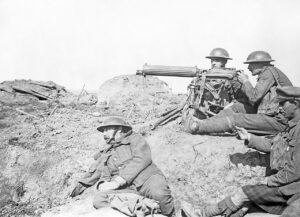 The dynamic of the world wars was probably different than most other wars…especially when it came to which units and countries were fighting side by side or against each other. When Britain declared war against Germany in August 1914, Australia was automatically also at war, because it was part of the British Empire. The New Zealand government (also under the sovereignty of the British Empire) followed without hesitation despite its geographic isolation and small population. The British Empire is for most of us, a difficult to understand group of countries that while largely independent, is also part of a larger government…the British Empire. The British Empire is a worldwide system of dependencies—colonies, protectorates, and other territories, that over a span of some three centuries was brought under the sovereignty of the crown of Great Britain and the administration of the British government. The policy of granting or recognizing significant degrees of self-government by dependencies, which was favored by the far-flung nature of the empire, led to the development by the 20th century of the notion of a “British Commonwealth” that was comprised of largely self-governing dependencies that acknowledged an increasingly symbolic British sovereignty. The term was embodied in statute in 1931. Today the Commonwealth includes former elements of the British Empire in a free association of sovereign states. Now, I don’t claim to understand the inner workings of the British Empire or the British Commonwealth, but Australia and New Zealand apparently had the option to join Britain in the war or to stand back and remain neutral. Both nations were loyal and joined Great Britain.
The dynamic of the world wars was probably different than most other wars…especially when it came to which units and countries were fighting side by side or against each other. When Britain declared war against Germany in August 1914, Australia was automatically also at war, because it was part of the British Empire. The New Zealand government (also under the sovereignty of the British Empire) followed without hesitation despite its geographic isolation and small population. The British Empire is for most of us, a difficult to understand group of countries that while largely independent, is also part of a larger government…the British Empire. The British Empire is a worldwide system of dependencies—colonies, protectorates, and other territories, that over a span of some three centuries was brought under the sovereignty of the crown of Great Britain and the administration of the British government. The policy of granting or recognizing significant degrees of self-government by dependencies, which was favored by the far-flung nature of the empire, led to the development by the 20th century of the notion of a “British Commonwealth” that was comprised of largely self-governing dependencies that acknowledged an increasingly symbolic British sovereignty. The term was embodied in statute in 1931. Today the Commonwealth includes former elements of the British Empire in a free association of sovereign states. Now, I don’t claim to understand the inner workings of the British Empire or the British Commonwealth, but Australia and New Zealand apparently had the option to join Britain in the war or to stand back and remain neutral. Both nations were loyal and joined Great Britain. 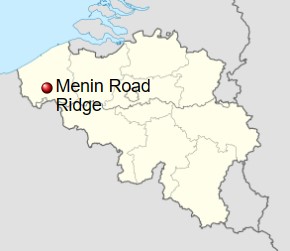
The Australian 6th Battalion was sent into warfare just two months after WWI began in August 1914. They met up with and joined the New Zealand Army, becoming the ANZAC (Australian and New Zealand Army Corps) from April 1915, while maintaining status as the Australian 6th Battalion until the unit was evacuated in December 1915. The Australian 6th Battalion fought German troops on the Western Front alongside the Allies. They were a good battalion, but for most of the time, there were no major decorations awarded…until. in September 1917, while serving in Belgium, Lieutenant Frederick Birks was awarded the only Victoria Cross ever granted within the unit. Sadly, Birks was killed in action the following day.
The Victoria Cross (VC) is “the highest and most prestigious decoration of the British honors system. It is awarded for valor ‘in the presence of the enemy’ to members of the British Armed Forces and may be awarded posthumously.” On September 17th, Birks’ battalion was moving parallel to a German line, with the orders to attack and capture the German line and blow them up. The men began moving toward their positions from Zillebeke on the night of September 18th, and immediately came under fire from gas shells. September 19th found the men holding their line, while the battalion prepared to attack the German line the next day. The battle that ensued became known as the Battle of Menin Road. Masked by a “light drizzle” of rain at 4am on  September 20th, the Germans sent barrages in front of and behind the battalion’s position. The battalion began their advanced at 5:40am. Birks and a corporal met the first German resistance and took two machine-gun positions, as another group of officers rushed a strong post. The Germans attacked the group with bombs, seriously wounding the corporal. Birks had to continue on alone. Birks advanced to the rear of the pillbox and forced the occupants to surrender. Birks went on to lead an attack a series of dugouts and pillboxes on the edge of Glencorse Wood, and fought against machine gun and bombs. He also assisted in the reorganization and consolidation of Australian men who had drifted away from their unit. September 21st brought more enemy shelling in response to the movement of Allied artillery. The shelling buried some men in Birks’ platoon. Birks attempted to dig the men out, “standing exposed” in the effort, another shell aimed at the C Coy post killed Birks, and four others, before he could save them. For his actions at Ypres, Birks was posthumously awarded the Victoria Cross, the announcement was made on November 8, 1917.
September 20th, the Germans sent barrages in front of and behind the battalion’s position. The battalion began their advanced at 5:40am. Birks and a corporal met the first German resistance and took two machine-gun positions, as another group of officers rushed a strong post. The Germans attacked the group with bombs, seriously wounding the corporal. Birks had to continue on alone. Birks advanced to the rear of the pillbox and forced the occupants to surrender. Birks went on to lead an attack a series of dugouts and pillboxes on the edge of Glencorse Wood, and fought against machine gun and bombs. He also assisted in the reorganization and consolidation of Australian men who had drifted away from their unit. September 21st brought more enemy shelling in response to the movement of Allied artillery. The shelling buried some men in Birks’ platoon. Birks attempted to dig the men out, “standing exposed” in the effort, another shell aimed at the C Coy post killed Birks, and four others, before he could save them. For his actions at Ypres, Birks was posthumously awarded the Victoria Cross, the announcement was made on November 8, 1917.
 Elephants are naturally non-aggressive animals. In fact, they are known to be one of the most emphatic and kind species in the whole animal kingdom. Their caring nature is well documented in dozens of videos online displaying their sensitivity and caring behavior both towards people and other elephants. Nevertheless, their very size, along with certain situations can make they very dangerous to humans. If elephants do attack humans or other animals, it is normally because they were provoked. Most attacks are acts of self-defense or the protection of their calves. Of course, there are other reasons, such as when they feel threatened or when they are harmed, ill, or mistreated. Females can be extremely aggressive when their young ones are nearby, similar to a mama bear. Male elephants are sometimes aggressive when displaying their dominance, or if they are experiencing musth, which is caused by a huge surge of testosterone, about 60 times the usual amount, and it makes even usually very calm bull Elephants aggressive. One other reason that elephants can be aggressive toward humans…sadly, is if they are trained to be aggressive toward humans.
Elephants are naturally non-aggressive animals. In fact, they are known to be one of the most emphatic and kind species in the whole animal kingdom. Their caring nature is well documented in dozens of videos online displaying their sensitivity and caring behavior both towards people and other elephants. Nevertheless, their very size, along with certain situations can make they very dangerous to humans. If elephants do attack humans or other animals, it is normally because they were provoked. Most attacks are acts of self-defense or the protection of their calves. Of course, there are other reasons, such as when they feel threatened or when they are harmed, ill, or mistreated. Females can be extremely aggressive when their young ones are nearby, similar to a mama bear. Male elephants are sometimes aggressive when displaying their dominance, or if they are experiencing musth, which is caused by a huge surge of testosterone, about 60 times the usual amount, and it makes even usually very calm bull Elephants aggressive. One other reason that elephants can be aggressive toward humans…sadly, is if they are trained to be aggressive toward humans.
In Ancient Asia, death by elephant was no accident…it was a popular form of execution. In this practice, elephants were trained to slowly break bones, crush skulls, twist off limbs, or even execute people using large blades fitted to their tusks. In some parts of Asia, this method of execution was still popular up to the late 19th 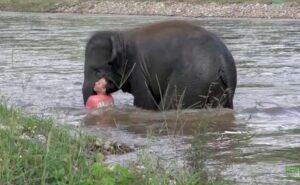 century. A form of capital punishment, execution by elephant was used in South and Southeast Asia, particularly in India, where Asian elephants were used to crush, dismember or torture captives in public executions. It was a form of capital punishment, but also used as a type of sport for the captors, and intimidation for everyone else. Depending on the “sentence” the elephants were trained to kill their victims immediately or to torture them slowly over a prolonged period of time, before killing them. It was a cruel and hideous form of “punishment” most commonly employed by royalty. Owning Executioner Elephants signified both the ruler’s power of life and death over his subjects and his ability to control wild animals. Elephant executions have been recorded in contemporary journals and accounts of life in Asia by European travelers. Before long, outrage over the cruelty of such practices brought about its eventual suppression by the European colonial powers that colonized the region in the 18th and 19th centuries. The practice was mostly confined to Asia, but it was occasionally used by Western and African powers, such as Ancient Rome and Carthage, particularly to deal with mutinous soldiers.
century. A form of capital punishment, execution by elephant was used in South and Southeast Asia, particularly in India, where Asian elephants were used to crush, dismember or torture captives in public executions. It was a form of capital punishment, but also used as a type of sport for the captors, and intimidation for everyone else. Depending on the “sentence” the elephants were trained to kill their victims immediately or to torture them slowly over a prolonged period of time, before killing them. It was a cruel and hideous form of “punishment” most commonly employed by royalty. Owning Executioner Elephants signified both the ruler’s power of life and death over his subjects and his ability to control wild animals. Elephant executions have been recorded in contemporary journals and accounts of life in Asia by European travelers. Before long, outrage over the cruelty of such practices brought about its eventual suppression by the European colonial powers that colonized the region in the 18th and 19th centuries. The practice was mostly confined to Asia, but it was occasionally used by Western and African powers, such as Ancient Rome and Carthage, particularly to deal with mutinous soldiers.

While some elephants were trained to be cruel and aggressive, the fact remains that this is not their natural behavior. In fact, there have been many accounts of elephants helping humans, and many of these were not because they were told to help, but rather that the elephants sensed that the human was in need of assistance. They are incredibly smart, and they see things around them clearly. They can even paint the things they see. They feel, they love, and they cry. Training these beautiful animals to kill was just as cruel to them as it was to their victims. I’m sure those executions were something the elephants could never forget.
 The world was a crazy place on August 20, 1945. It was just eleven days after the atomic bombing of Nagasaki, Japan. The world was a little “scary.” Just knowing that entire towns could be blown off the face of the earth in an instant, changed the whole perspective of life as we knew it. The war was almost over. By September 2, 1945, World War II would be a blip in the rearview mirror of history. Maybe it was time to look for something…happy, for a change.
The world was a crazy place on August 20, 1945. It was just eleven days after the atomic bombing of Nagasaki, Japan. The world was a little “scary.” Just knowing that entire towns could be blown off the face of the earth in an instant, changed the whole perspective of life as we knew it. The war was almost over. By September 2, 1945, World War II would be a blip in the rearview mirror of history. Maybe it was time to look for something…happy, for a change.
Enter Brooklyn Dodgers utility player, Tommy Brown. He was a local kid, who was born December 6, 1927, in the Bensonhurst section of Brooklyn. Brown never knew his father and was raised primarily by an aunt and uncle. That was probably the best thing that could have happened. Brown’s upbringing was such that he was able to make something of himself. He started playing baseball, and he was good enough to be called up to the Majors. Brown made his debut with the Dodgers in 1944, when he was just 16 years old. It was an unusual time, because during World War II, millions of men served overseas, so the ball players were serving in the military. Men like future Hall of Famers Ted Williams and Yogi Berra were among them. That left a group of aspiring teenagers in line for the majors in an almost unheard of shot in the big leagues. Fifteen-year-old Joe Nuxhall was also called up and pitched 2/3 of an inning for the Cincinnati Reds in the summer of 1944. It would be almost like they were replacement players.
On August 3, 1944, while playing for the Newport News (Virginia) Builders of the Class B Piedmont League, Brown got the call that changed not only his life, but baseball history forever. He was headed to the majors, 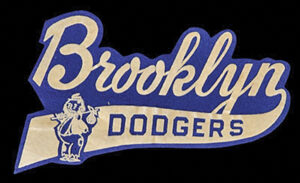 with the Brooklyn Dodgers. Apparently, they had tried Bobby Bragan at shortstop but were looking for someone more mobile. Dodgers’ manager Leo Durocher told Brown that day he would play both games of a doubleheader against the Chicago Cubs. After that shock wore off…for about a second, “Brown, according to a bio on the Society of American Baseball Research web site, advised his manager that he had ridden the train all night, ‘but Leo responded that he didn’t care.'” I guess they were desperate. Brown became the youngest non-pitcher ever to play in a major league game, and the second-youngest overall after Joe Nuxhall, who was 15 years and 316 days old when he first appeared as a pitcher for the Cincinnati Reds on June 10, 1944. He got two hits in eight at-bats as the Cubs beat the Dodgers in both games, 6-2 and 7-1. In 1944, he played a total of 46 games, hitting .164 without a homer. Brown, nicknamed “Buckshot,” threw and batted right-handed. He stood 6 feet 1 inch tall and weighed 170 pounds. Then, on August 20, 1945, he hit a home run…his team’s only run in an 11-1 loss to the Pittsburgh Pirates. He finished that season with a .245 batting average. That home run may not seem like much, but remember that Brown was just 16 years old at the time. With that “homer” to
with the Brooklyn Dodgers. Apparently, they had tried Bobby Bragan at shortstop but were looking for someone more mobile. Dodgers’ manager Leo Durocher told Brown that day he would play both games of a doubleheader against the Chicago Cubs. After that shock wore off…for about a second, “Brown, according to a bio on the Society of American Baseball Research web site, advised his manager that he had ridden the train all night, ‘but Leo responded that he didn’t care.'” I guess they were desperate. Brown became the youngest non-pitcher ever to play in a major league game, and the second-youngest overall after Joe Nuxhall, who was 15 years and 316 days old when he first appeared as a pitcher for the Cincinnati Reds on June 10, 1944. He got two hits in eight at-bats as the Cubs beat the Dodgers in both games, 6-2 and 7-1. In 1944, he played a total of 46 games, hitting .164 without a homer. Brown, nicknamed “Buckshot,” threw and batted right-handed. He stood 6 feet 1 inch tall and weighed 170 pounds. Then, on August 20, 1945, he hit a home run…his team’s only run in an 11-1 loss to the Pittsburgh Pirates. He finished that season with a .245 batting average. That home run may not seem like much, but remember that Brown was just 16 years old at the time. With that “homer” to 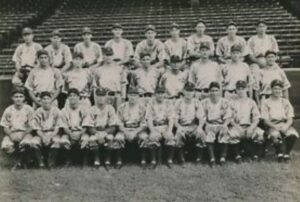 his credit, Brown remains the youngest player to homer in a Major League Baseball game, a record that will likely never be broken.
his credit, Brown remains the youngest player to homer in a Major League Baseball game, a record that will likely never be broken.
Brown played seven more seasons in the big leagues, spending time with the Philadelphia Phillies and Cubs after leaving Brooklyn. He never became anything more than a part-time player, but he will always have the distinction of youngest person to homer to his credit. Brown married a woman from Nashville and stayed in that area after his playing career ended. He worked at the Ford Glass Plant for thirty-five years, before retiring in 1993. He continues to live in retirement in Brentwood, Tennessee.
 Any time you are working with or storing gun powder or other explosives, you run the risk of an explosion. I don’t think that any such explosion is death-free, unless possibly if the factory or warehouse is empty at the time. That is unlikely, because most of these places have at the very least, security personnel working there 24/7 and many run shifts around the clock as well. Of course, that is in today’s world. Back in 1769, however, it is unlikely that people were in the facility 24/7.
Any time you are working with or storing gun powder or other explosives, you run the risk of an explosion. I don’t think that any such explosion is death-free, unless possibly if the factory or warehouse is empty at the time. That is unlikely, because most of these places have at the very least, security personnel working there 24/7 and many run shifts around the clock as well. Of course, that is in today’s world. Back in 1769, however, it is unlikely that people were in the facility 24/7.
A part of the Republic of Venice…Brescia was the site of the Bastion of San Nazaro, a military arsenal and powder storage area. About 200,000 pounds of black powder was stored at the site, enough to destroy about a sixth of the city when a lightning bolt set off the blast in 1769. Because buildings then were not built in such a way as to protect from fire and lightning, there was more risk of disaster than we have today, and there is plenty of 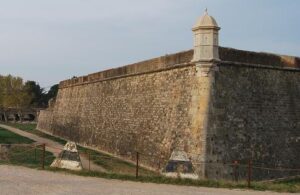 risk today, but possibly less from lightning. Unfortunately, in 1769, disaster came in the form of lightning striking the structure. The ensuing explosion actually devastated the town. When the lightning struck, it started a fire that ignited 198,416 pounds of gunpowder stored at the bastion. As the fire burned, it caused a massive explosion which destroyed one-sixth of the Brescia and killed approximately 6,000 people. Giant rocks and building stones were launched about a kilometer away in every direction, causing massive damage to the surrounding area and crushing unfortunate people. The blast also blew out windows and blew in doors to buildings over a wide area.
risk today, but possibly less from lightning. Unfortunately, in 1769, disaster came in the form of lightning striking the structure. The ensuing explosion actually devastated the town. When the lightning struck, it started a fire that ignited 198,416 pounds of gunpowder stored at the bastion. As the fire burned, it caused a massive explosion which destroyed one-sixth of the Brescia and killed approximately 6,000 people. Giant rocks and building stones were launched about a kilometer away in every direction, causing massive damage to the surrounding area and crushing unfortunate people. The blast also blew out windows and blew in doors to buildings over a wide area.
With a reported death toll of around 6000, this Italian disaster ranks among the worst of the black powder explosions of all time. Who would have thought that an explosion could take out one-sixth of a city? Today,  Brescia has over 200,000 people, and while we don’t know the population back then, we know that a devastation of one-sixth of it killed 3,00 to 6,000 people, so it must have had as many as 50,000 people living there in 1769. The number of fatalities varies among those making estimates, with some saying 3,000. Nevertheless, 3,000 or 6,000 is irrelevant because any loss of life is devastating. This particular tragedy motivated Benjamin Franklin to experiment with the use of lightning rods to protect powder storage buildings. His work found a way to help make buildings a little safer and so lightning rod usage was advised in powder storage buildings…advice apparently taken by the British.
Brescia has over 200,000 people, and while we don’t know the population back then, we know that a devastation of one-sixth of it killed 3,00 to 6,000 people, so it must have had as many as 50,000 people living there in 1769. The number of fatalities varies among those making estimates, with some saying 3,000. Nevertheless, 3,000 or 6,000 is irrelevant because any loss of life is devastating. This particular tragedy motivated Benjamin Franklin to experiment with the use of lightning rods to protect powder storage buildings. His work found a way to help make buildings a little safer and so lightning rod usage was advised in powder storage buildings…advice apparently taken by the British.
 There are many unique towns in this world, but I think very few of them could rival the town of Suloszowa, in Poland. The town was nicknamed “Little Tuscany” because of its unusual layout. Suloszowa is located in southern Poland, 29 kilometers northwest of Krakó. The one thing that makes Suloszowa so strange is the fact that the town has one street in it…an almost 6-mile-long street, on which the only turns are into someone’s property. Any stores in the town are located on that one street as well. The main street of Suloszowa is called Olkuska. It is such a strange thing to have only one street in town, and by the way, it also forms Route 773, which crosses the town from end to end.
There are many unique towns in this world, but I think very few of them could rival the town of Suloszowa, in Poland. The town was nicknamed “Little Tuscany” because of its unusual layout. Suloszowa is located in southern Poland, 29 kilometers northwest of Krakó. The one thing that makes Suloszowa so strange is the fact that the town has one street in it…an almost 6-mile-long street, on which the only turns are into someone’s property. Any stores in the town are located on that one street as well. The main street of Suloszowa is called Olkuska. It is such a strange thing to have only one street in town, and by the way, it also forms Route 773, which crosses the town from end to end.
Think about the neighbors you have. Are their yards messy? Do they play their music too loud? Are their vehicles too loud? Now imagine that your “neighbors” are everyone in town. Imagine the local motorcycle “speed freak” who is always screaming down your little block-long street. Now imagine that the local “speed freak” had almost 6 miles to get through the block…lots of time to pick up speed. If your neighborhood was one in which the irritations never end, a street like Olkuska could be a nightmare, but the people of Suloszowa seem to get  along!! All the 5,819 (as of 2017) people in town live in harmony with each other as they share the single road that stretches through the town. How’s that for strange?
along!! All the 5,819 (as of 2017) people in town live in harmony with each other as they share the single road that stretches through the town. How’s that for strange?
The town of Suloszowa is what is known as “a linier settlement, which is a (normally small to medium-sized) settlement or group of buildings that is formed in a long line. Many of these settlements are formed along a transport route, such as a road, river, or canal. Others form due to physical restrictions, such as coastlines, mountains, hills or valleys. Linear settlements may have no obvious center.” On both sides of the Olkuska Street, or the only street in the town of Suloszowa, people have built houses adjacent to one another. They all have rectangular gardens or fields that stretch far away from the main road of the town. The view from the air is…stunning, and a photo of it recently went viral on social media. With that, the people of the town decided to  share their experiences of living in the single-street town. One said, “I wouldn’t trade this place for anything else. It has its own charm and atmosphere. As the saying goes, there’s something about it.” I think that all the people share the same sentiment.
share their experiences of living in the single-street town. One said, “I wouldn’t trade this place for anything else. It has its own charm and atmosphere. As the saying goes, there’s something about it.” I think that all the people share the same sentiment.
As for Suloszowa, the route predated the settlement. Then when the settlement grew, no other roads were added. I’m sure that when people purchased the land behind their homes, it made the idea of additional streets even more difficult, and since the people all got along so well, the town was just left it as it was. Adding additional streets soon became a non-issue, and new purchases were just added to the ends of the street. The people added, “The whole place looks the same: there is a house and then a strip of field, hence the beauty of the photos. One has grain, the other has rapeseed, and the third has something else. The colors look beautiful from above.” I must agree…the aerial photo is beautiful.
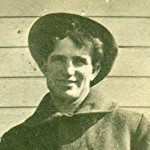
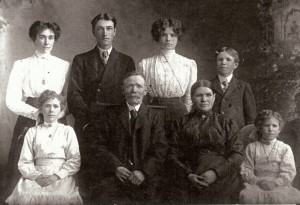 When I think of my grandfather, Allen Luther Spencer, who was my dad, Allen Lewis Spencer’s dad, I usually think of his carpenter days with the Great Northern Railroad. That is because that was the job he held for probably most of his working years. I have seen a desk that he made, and it is beautiful, but of course, there weren’t many, or maybe not any, desks on railroad trains. Mostly he made things like seats, probably, unupholstered, which I would find extremely uncomfortable these days. I have ridden on trains from that era, and those old bench seats were not meant for long trips. Still, the workmanship is interesting, and they were well designed. I don’t know what kind of seats or other things my grandfather build, but I know that he was a talented carpenter.
When I think of my grandfather, Allen Luther Spencer, who was my dad, Allen Lewis Spencer’s dad, I usually think of his carpenter days with the Great Northern Railroad. That is because that was the job he held for probably most of his working years. I have seen a desk that he made, and it is beautiful, but of course, there weren’t many, or maybe not any, desks on railroad trains. Mostly he made things like seats, probably, unupholstered, which I would find extremely uncomfortable these days. I have ridden on trains from that era, and those old bench seats were not meant for long trips. Still, the workmanship is interesting, and they were well designed. I don’t know what kind of seats or other things my grandfather build, but I know that he was a talented carpenter.
Grandpa met my grandmother, Anna Schumacher Spencer, through her brother, Albert Schumacher, who was his good friend. Once he got to know the family, he did his best to be a good son-in-law to my great grandparents, Carl and Albertine Schumacher, and brother-in-law to the younger kids. My great grandparents had a 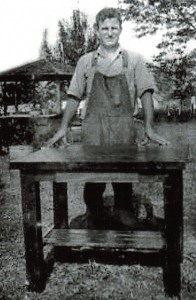 ten-acre lake on their property in those days, but it wasn’t really anything the kids could exactly enjoy, so my grandfather decided to seed the lake with fish, so they could go fishing, and it would provide food for the family for years to come. He also built a flat-bottom boat so the kids could actually go out on the lake to do their fishing. The boat isn’t surprising, since he was a carpenter, but seeding the lake. Who knew that he knew anything about that?
ten-acre lake on their property in those days, but it wasn’t really anything the kids could exactly enjoy, so my grandfather decided to seed the lake with fish, so they could go fishing, and it would provide food for the family for years to come. He also built a flat-bottom boat so the kids could actually go out on the lake to do their fishing. The boat isn’t surprising, since he was a carpenter, but seeding the lake. Who knew that he knew anything about that?
Life wasn’t always easy for my grandparents. They went through a number of tough years in history. It’s hard for me to believe, but my grandpa was born just fourteen years after the Civil War ended. Our nation had witnessed its first Presidential assassination (later, there would be four more, and of these, my grandfather would be alive for two). The nation was likely still reeling from the Lincoln assassination in 1865, when in 1881, James Garfield was assassinated, followed by William McKinley in 1901. In my lifetime, we have had one successful assassination, when President Kennedy was assassinated. The identity of the perpetrator or perpetrators is still a source of contention on that one to this day. There have been plots and attempts on most presidents, but we may not have heard of most of them. Politics can be a dangerous game.
My grandparents also lived through World War I and II, as well as the “Roaring Twenties” and the Great Depression. Grandpa spent time farming, as well as the oil fields of Texas, the lumber industry of Northern Minnesota, and the Great Northern Railroad. He even did a little time in the fur trade, trapping a number of animals, including skunks (wow), but I don’t think he found that to be very successful…and I’m sure the smell 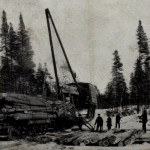
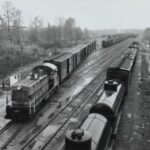 was not his favorite thing either. Looking back at Grandpa’s life, I would have to say that he led an “interesting” sort of life. He had, what could be classified as several careers before he retired. I never met my grandfather. He passed away in 1951. I think that when I meet him in Heaven, I will spend quite some time asking him about his life. I think that as a “history buff,” I will really find his life an interesting story. Today is the 144th anniversary of my grandfather’s birth. Happy birthday in Heaven, Grandpa Spencer. We love and miss you very much.
was not his favorite thing either. Looking back at Grandpa’s life, I would have to say that he led an “interesting” sort of life. He had, what could be classified as several careers before he retired. I never met my grandfather. He passed away in 1951. I think that when I meet him in Heaven, I will spend quite some time asking him about his life. I think that as a “history buff,” I will really find his life an interesting story. Today is the 144th anniversary of my grandfather’s birth. Happy birthday in Heaven, Grandpa Spencer. We love and miss you very much.
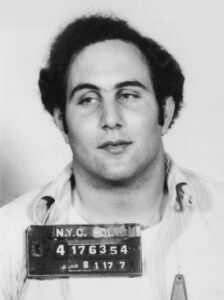 Mental illness can cause people to do insane things. On August 10, 1977, a 24-year-old postal employee named David Berkowitz was arrested and charged with being the “Son of Sam” serial killer who terrorized New York City for more than a year. He killed six young people and wounded seven others with a .44-caliber revolver. Serial killers have a specific type of target victim, and Berkowitz generally targeted attractive young women with long brown hair. The women in New York City were so frightened that hundreds of young women had their hair cut short and dyed blonde during the time “Son of Sam” terrorized the city. Thousands more women were too scared to even leave their homes at night.
Mental illness can cause people to do insane things. On August 10, 1977, a 24-year-old postal employee named David Berkowitz was arrested and charged with being the “Son of Sam” serial killer who terrorized New York City for more than a year. He killed six young people and wounded seven others with a .44-caliber revolver. Serial killers have a specific type of target victim, and Berkowitz generally targeted attractive young women with long brown hair. The women in New York City were so frightened that hundreds of young women had their hair cut short and dyed blonde during the time “Son of Sam” terrorized the city. Thousands more women were too scared to even leave their homes at night.
August 10th finally brought his reign of terror to an end. After his arrest, Berkowitz claimed that demons and a black Labrador retriever owned by a neighbor named Sam had ordered him to commit the killings. These statements were the first signs that Berkowitz was a Paranoid Schizophrenic…a condition he was later diagnosed with. Mental illness is not an excuse for murder, but I suppose it is an explanation of sorts. David Berkowitz was born Richard David Falco on June 1, 1953, in Brooklyn, New York. His biological mother, Elizabeth “Betty” Broder, placed him for adoption within a few days. His biological father, Joseph Klineman was a married man with whom Broder had a three-year affair. ? The exact reason for Broder’s decision is unknown, but it has been speculated that Klineman threatened to leave her if she kept the baby and if she used his name. Although her reasons for giving Richard away are unknown, have surmised that Klineman threatened to abandon her if she kept the baby and used his name. Broder had grown up as part of an impoverished Jewish family and was working as a waitress. Prior to meeting Klineman, in 1936. She married Tony Falco, an Italian American, who left her for another woman less than four years later. David Berkowitz was adopted by Pearl and Nathan Berkowitz. David loved his adoptive parents and did well until he was traumatized by the death of his adoptive mother from cancer in 1967. That event caused him to become a recluse. In 1971, Berkowitz joined the army and served for three years. He seemed to be in his element and distinguished himself as a talented marksman. In 1974, he returned to New York and worked as a security guard, but his mental condition began to severely deteriorate in 1975. Still a recluse, he began to feel very isolated from the world around him, and he set hundreds of arson fires in New York without being caught.
It was at this time that he began to hear voices of, in his own words, “demons” that tormented him and told him to commit murder. His first attempt came on Christmas Eve, 1975, when is gave into the “demons” and severely wounded 15-year-old Michelle Forman with a hunting knife. In January 1976, after moving into a two-family home in Yonkers, Berkowitz became convinced that the German shepherd that lived in the house and other neighborhood dogs were possessed by demons who ordered him to murder attractive young women. It seems so strange that he connected dogs with the voices his disease caused him to hear. Then his condition progressed, and he also started seeing his neighbors as demons. In April, Berkowitz moved to an apartment house in Yonkers, but this new home also had dogs. His neighbor, retiree Sam Carr, had a black Labrador retriever named Harvey, who Berkowitz believed pleaded with him to kill. He also saw Sam Carr as a powerful demon and was referring to him when he began calling himself “Son of Sam.” On July 28, 1976, Berkowitz quit his job as a security guard, and the killing spree began. Over the next year, Berkowitz killed 6 women. He wounded 11 more, two of which were actually stabbed in 1975. His fatal victims were Donna Lauria, Christine Freund, Virginia Voskerichian, Valentina Suriani, Alexander Esau (Esau was only killed because he was in the way as he kissed Valentina Suriani), and Stacy Moskowitz who was also kissing her boyfriend. Bobby Violante, lost his left eye and nearly all the vision in his right eye, but he lived.
Finally getting a ballistics match after the killing of Virginia Voskerichian, it was determined that this was a serial killer. The New York police announced that a serial killer was on the loose, known to be a white male in his 20s, with black hair and of average height and build. A task force was assembled, called “The Omega Task Force.” Berkowitz was getting brave, now leaving a note with his victims identifying himself as “Son of Sam.” Then, on April 29, Berkowitz shot Sam Carr’s Labrador retriever. He had previously sent an anonymous, threatening letter to Mr Carr concerning the animal. The dog recovered, and the Yonkers police began an investigation. Then, Berkowitz started sending insane letters to other neighbors and his former landlords. These people began to suspect Berkowitz and called the police. individuals began to suspect Berkowitz to be the Son of Sam and reported their suspicions to local police. Still, the detectives of The Omega Task Force, even after receiving thousands of reports of Son of Sam “suspects” and were nevertheless having a difficult time sifting through all the dead-end leads.
On June 26, the Son of Sam struck again, wounding Judy Placido and Sal Lupo as they sat in their car after leaving a Queens disco. A few days later, a major break in the case came when an eyewitness came forward to report that she had seen a man with what looked like a gun minutes before the shots were fired in Brooklyn. Her information led to the first police sketch of Berkowitz. More important, she reminded investigators that two police officers had been writing parking tickets on her street that night. A search of tickets issued eventually turned up Berkowitz’s car. At the same time, Yonkers police investigated Berkowitz after he escalated a harassment campaign against one of his neighbors. Convinced he was the “Son of Sam” they informed the Omega task force of their findings. The Omega detectives finally put two and two together, and on August 10 David Berkowitz was arrested while leaving his Yonkers home. He excitedly admitted to being the “Son of Sam.” It was like it had all been a game of “hide and seek” in his mind. At the time, he had his semiautomatic rifle. He told them that he was on his way to commit another murder. The .44-caliber revolver was also recovered. 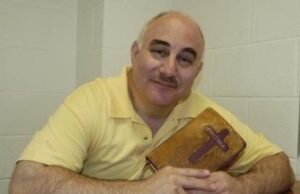 There was some question about whether Berkowitz was mentally fit to stand trial, but on May 8, 1978, he changed his insanity plea to guilty on six counts of murder. The whole time, he seemed to enjoy the publicity. The case prompted New York state to adopt the first in a nationwide series of so-called “Son of Sam laws” that take proceeds a criminal earns from selling their story and gives them to a victims’ compensation fund.
There was some question about whether Berkowitz was mentally fit to stand trial, but on May 8, 1978, he changed his insanity plea to guilty on six counts of murder. The whole time, he seemed to enjoy the publicity. The case prompted New York state to adopt the first in a nationwide series of so-called “Son of Sam laws” that take proceeds a criminal earns from selling their story and gives them to a victims’ compensation fund.
Berkowitz was given six 25-years-to-life sentences for the crime, the maximum penalty allowed at the time. He has since been denied parole. He is currently held at the Shawangunk Correctional Facility in upstate New York, where he allegedly converted to Christianity. I pray that is so.
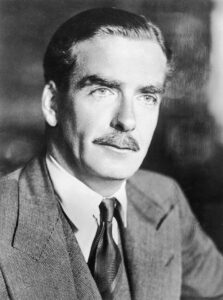 Out of necessity, comes innovation. Many of history’s great problems were solved because it was a necessity. For the most part, Britain has maintained a small British Army. Somehow, probably mostly due to geography, rather than might, the British Royal Navy was able to protect the island nation from its enemies quite well…until World War I, that is, and indeed, young men did not feel the need to join the army due to patriotic duty, but rather due to a shortage of other working options. In fact, a career in the military wasn’t looked upon favorably at all.
Out of necessity, comes innovation. Many of history’s great problems were solved because it was a necessity. For the most part, Britain has maintained a small British Army. Somehow, probably mostly due to geography, rather than might, the British Royal Navy was able to protect the island nation from its enemies quite well…until World War I, that is, and indeed, young men did not feel the need to join the army due to patriotic duty, but rather due to a shortage of other working options. In fact, a career in the military wasn’t looked upon favorably at all.
When World War I broke out in 1914, Britain suddenly experienced a huge shortage of trained military personnel, especially officers. This was further complicated by heavy casualties in the British Expeditionary Force in France, which dwindled the limited supply even further. That meant to keep up, they were going to need a large number of officers to be sourced and trained quickly. Their only real solution was to take young upper-class men and put them through officer training. These were teenagers, young men still in school, but it was necessary, and so schooling was either ended or postponed.
During World War I, as was seen with the RMS Titanic, class was considered of the utmost importance. In Britain, only a gentleman could be an officer. The working-class and lower-class men were put in as the average 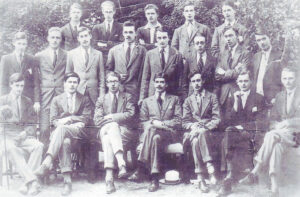 soldier. Somehow it was thought that “Short of actual military credentials, a person’s schooling was thought to be a reasonable litmus test for leadership.” To further confuse things in the minds of most Americans these days, a public school in Britain is actually a very exclusive private institution. Eton College, a private institution attended by no fewer than 20 prime ministers, is probably the best example of that. Anthony Eden, who would later become prime minister, was an Eton alum, who also served as an officer in the British Army.
soldier. Somehow it was thought that “Short of actual military credentials, a person’s schooling was thought to be a reasonable litmus test for leadership.” To further confuse things in the minds of most Americans these days, a public school in Britain is actually a very exclusive private institution. Eton College, a private institution attended by no fewer than 20 prime ministers, is probably the best example of that. Anthony Eden, who would later become prime minister, was an Eton alum, who also served as an officer in the British Army.
When World War I broke out, Eden was just 17, and after a rushed officer training course, he was commissioned as a second lieutenant a year later. It seems strange and almost reckless to have upper-class teenagers leading working-class soldiers, but in this case, it actually worked well. The teenage future prime minister recalled his men “were tolerant of me as we were all learning together.” Eden quickly learned that “As long as the officer showed proper concern for the well-being of his men and courage under fire, the men in turn would show great loyalty.”
The commissioned officers were also helped enormously by the noncommissioned officers. The 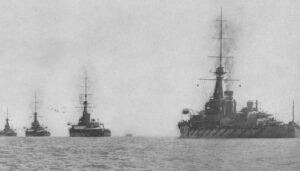 noncommissioned officers were usually working-class men who had been promoted from the ranks after showing leadership abilities throughout their military careers. Thankfully so, because as Eden would later recall of a sergeant named Arnold Rushworth in his post-war memoirs, “He was my right hand and no small part of my brain as well.” I’m sure that part of the reason this plan of upper-class men becoming officers worked was the sheer compassion of the working-class men, who helped them along the way. It was the way of the times, and I suppose that the men simply accepted their “position” in life as being the way things were, and that it could not be changed.
noncommissioned officers were usually working-class men who had been promoted from the ranks after showing leadership abilities throughout their military careers. Thankfully so, because as Eden would later recall of a sergeant named Arnold Rushworth in his post-war memoirs, “He was my right hand and no small part of my brain as well.” I’m sure that part of the reason this plan of upper-class men becoming officers worked was the sheer compassion of the working-class men, who helped them along the way. It was the way of the times, and I suppose that the men simply accepted their “position” in life as being the way things were, and that it could not be changed.
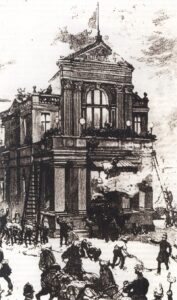 In American schools, and maybe in schools all over the world, children are used to the occasional fire drill, because it is a practice is designed to allow people to escape a fire, instead of losing their lives in a panic. Of course, this practice is fairly new, and came about after a number of fire disasters. One such disaster was the September 5, 1887, Exeter Theatre Royal fire in Exeter, England.
In American schools, and maybe in schools all over the world, children are used to the occasional fire drill, because it is a practice is designed to allow people to escape a fire, instead of losing their lives in a panic. Of course, this practice is fairly new, and came about after a number of fire disasters. One such disaster was the September 5, 1887, Exeter Theatre Royal fire in Exeter, England.
The fire broke out in the backstage area of the theatre during the production of “The Romany Rye” by George Robert Sims and produced by Wilson Barrett. When the fire was known, a panic ensued throughout the theatre. Whenever there is panic, someone is going to get hurt, or worse. In this case, 186 people died from a combination of the direct effects of smoke and flame, crushing and trampling, and trauma injuries from falling or jumping from the roof and balconies. It is such a sad situation, because if they had not panicked, it is likely that all or most of those would have survived. Of course, panic was not the only reason for the deaths, so we will never truly know if this could have been prevented. The Exeter Theatre Royal death toll makes it the worst theatre disaster, the worst single-building fire, and the third worst fire-related disaster in the history of the United Kingdom. Most of those who lost their lives were in the gallery of the theatre, which had only a single exit with several design flaws. The exit quickly became clogged with people trying to escape.
This was not the first time the Theatre Royal had been destroyed. The first Exeter Theatre Royal had been gutted by fire in 1885, and the new theatre was opened, on a new site, in 1886 to the design of well-known theatre architect CJ Phipps. The new theatre was leased exclusively to Sidney Herberte-Basing. The new 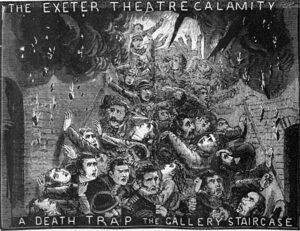 building was constructed from stone and red brick on the outside, but the inside was largely constructed of wood. Following the 1885 fire, the licensing authority of Exeter City Council ordered that the new theatre be constructed “in accordance with the rules and regulations of the Metropolitan Board of Works,” which was a statutory requirement in London under The Metropolitan Building Act 1855 (with theatre particulars added in the 1878 amendment), but not required in the regions. In his letter accompanying the plans to the Corporation Surveyor of Exeter City Council, Phipps directly states that the building met all the rules and requirements laid out, ans added that he had extensive experience in these types of construction. The letter stated, “…the theatre is designed in accordance with the rules and regulations of the Board of Works under the Act of 1878 and of the Lord Chamberlain – and having constructed some 40 theatres, I bring a somewhat large experience to bear on this subject.” – C.J. Phipps, Letter of 11 July 1885 from Phipps to the Corporation Surveyor of the City of Exeter.
building was constructed from stone and red brick on the outside, but the inside was largely constructed of wood. Following the 1885 fire, the licensing authority of Exeter City Council ordered that the new theatre be constructed “in accordance with the rules and regulations of the Metropolitan Board of Works,” which was a statutory requirement in London under The Metropolitan Building Act 1855 (with theatre particulars added in the 1878 amendment), but not required in the regions. In his letter accompanying the plans to the Corporation Surveyor of Exeter City Council, Phipps directly states that the building met all the rules and requirements laid out, ans added that he had extensive experience in these types of construction. The letter stated, “…the theatre is designed in accordance with the rules and regulations of the Board of Works under the Act of 1878 and of the Lord Chamberlain – and having constructed some 40 theatres, I bring a somewhat large experience to bear on this subject.” – C.J. Phipps, Letter of 11 July 1885 from Phipps to the Corporation Surveyor of the City of Exeter.
Nevertheless, during the licensing inspection, several deficiencies were noted and ordered to be corrected, including “installing an additional exit for the audience from the boxes, stalls, and pit, widening the exits to at 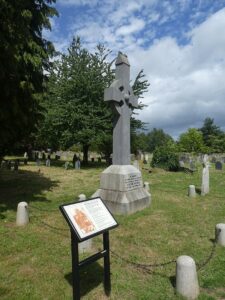 least 6 feet, changing some single leaf exit doors to double doors, and supplying 80 feet of hose for each hydrant (of which there were only two – one in the foyer and one in the “prompts” in front of the stage), rather than 40 feet which had been provided.” Unfortunately, there was no inspection of the stage, the mezzanine floor, or the fly galleries above the stage. There was only one exit with four right angled turns in it, from this area, and while two exits were called for, the idea was passed over because Phipps asserted “that a second exit was provided by climbing the railing at the front of the gallery and dropping to the second circle below.” That was, of course a crazy notion, that cost lives in the end. Apparently, this plan was accepted without further argument. In addition, there was to be an iron safety curtain, which was not fitted at the time of the fire, and a fire hydrant in the stage wings was on the plans of the theatre but never installed, despite Phipps being advised that the two hydrants installed were insufficient. In the end, the panic, along with the mishandled inspections and the improper plan design cost 186 people their lives.
least 6 feet, changing some single leaf exit doors to double doors, and supplying 80 feet of hose for each hydrant (of which there were only two – one in the foyer and one in the “prompts” in front of the stage), rather than 40 feet which had been provided.” Unfortunately, there was no inspection of the stage, the mezzanine floor, or the fly galleries above the stage. There was only one exit with four right angled turns in it, from this area, and while two exits were called for, the idea was passed over because Phipps asserted “that a second exit was provided by climbing the railing at the front of the gallery and dropping to the second circle below.” That was, of course a crazy notion, that cost lives in the end. Apparently, this plan was accepted without further argument. In addition, there was to be an iron safety curtain, which was not fitted at the time of the fire, and a fire hydrant in the stage wings was on the plans of the theatre but never installed, despite Phipps being advised that the two hydrants installed were insufficient. In the end, the panic, along with the mishandled inspections and the improper plan design cost 186 people their lives.
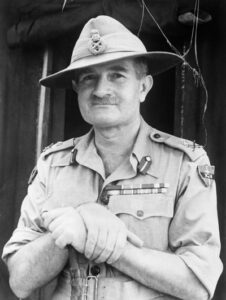
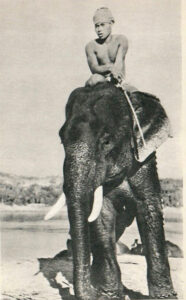 Most of us would never think of using an elephant in a battle, but James Howard Williams, also known as Elephant Bill, who was a British soldier and elephant expert in Burma thought about it. Born on November 15, 1897, at Saint Just, Cornwall, he was the son of a Cornish mining engineer, who had returned to Cornwall from South Africa, and his wife, a Welshwoman. Williams went to college at Queen’s College in Taunton, and following in his brother’s footsteps, studied at Camborne School of Mines. He then went on to serve as an officer in the Devonshire Regiment of the British Army in the Middle East during the First World War and in Afghanistan from 1919 to 1920. Williams served with the Camel Corps and as transport officer in charge of mules. The military was very different then, from what we know today. After his service was over, he decided to join the Bombay-Burmah Trading Corporation as a forester working with elephants to extract teak logs. Little did he know that this would be a life changing decision for him.
Most of us would never think of using an elephant in a battle, but James Howard Williams, also known as Elephant Bill, who was a British soldier and elephant expert in Burma thought about it. Born on November 15, 1897, at Saint Just, Cornwall, he was the son of a Cornish mining engineer, who had returned to Cornwall from South Africa, and his wife, a Welshwoman. Williams went to college at Queen’s College in Taunton, and following in his brother’s footsteps, studied at Camborne School of Mines. He then went on to serve as an officer in the Devonshire Regiment of the British Army in the Middle East during the First World War and in Afghanistan from 1919 to 1920. Williams served with the Camel Corps and as transport officer in charge of mules. The military was very different then, from what we know today. After his service was over, he decided to join the Bombay-Burmah Trading Corporation as a forester working with elephants to extract teak logs. Little did he know that this would be a life changing decision for him.
Williams learned so much about the elephants in Burma, that it was during that time he acquired his nickname, “Elephant Bill.” While his biggest calling was his work with the Fourteenth Army during the Burma Campaign of World War II, he was also known for his 1950 book Elephant Bill. He was made a Lieutenant-Colonel, mentioned in dispatches three times, and was awarded the OBE in 1945. His interest in elephants came after he read a book by Hawkes, called “The Diseases of the Camel and the Elephant” and decided on the postwar job in Burma. Initially he was at a camp on the banks of the Upper Chindwin River in Upper Burma. There, Williams was responsible for seventy elephants and their oozies (in Burma an oozie was an elephant trainer) in ten camps, in an area of about 400 square miles in the Myittha Valley, in the Indaung Forest Reserve. The camps were 6 to 7 miles apart. Between the camps were hills, three to four thousand feet high and filled with teak. To mill them, one tree was killed by ring-barking the base, and then felled. The three-year-old trees were mature and were now light enough to float. The logs were hauled by elephant (known as “sappers”) to a waterway, then floated down to Rangoon or Mandalay. The elephants were needed by the Royal Engineers for use in bridge building in places where heavy equipment could otherwise not be brought in, the Royal Indian Army Service Corps wanted them to be regarded simply as a branch of transport, but they also had great value in rescue. Elephants were so important to the harvesting process, that one elephant could be sold for $150,000, which is $2000 in American dollars. The elephants were as big a commodity as the teak wood. Believe it or not, teak was “as important a munition of war as steel,” so its extraction was an essential industry.
While elephants were most often used to extract the teak from the forests, they were used for another important extraction during World War II. When Japan entered the war, it was expected that they would be held in Malaya and Singapore. While many people were critical of them, the Bombay Burma Corporation arranged evacuation of European women and children, even though the government had no such plans. That evacuation took place in 1942, from February till the end of April. The retreat from Burma was to Assam via Imphal. The road to Assam went up the Chindwin to Kalewa, then up the Kabaw Valley to Tamu, and across five thousand-foot-mountains into Manipur and the Imphal Plain. During this time, Williams was attached to one evacuation party, which also included his wife and children. The Kabaw Valley was nicknamed “The Valley of Death” because of the hundreds of refugees who died there from exhaustion, starvation, cholera, dysentery, and smallpox. Nevertheless, while many people died along the way, many were also saved due to the elephant evacuation process. The well known “elephant whisperer” and his best beloved helpers waged guerrilla warfare and carried refugees to safety. They sometimes had to fight, possibly even while working to help the refugees to escape. He was a Burmese speaker with knowledge of Burma, including the Irrawaddy River area and jungle tracks, which gave him a distinct edge when it came to getting precious human cargo out of the danger zones.
Not all treatment of elephants during that time was humane, and many elephants that were captured by the Japanese, and later recaptured by Williams’ group and others like it, had to be “cured” after being attacked by Allied fighters when they were used in Japanese warfare, or treated for acid burns from wireless batteries carried on their backs in straw-lined boxes. I’m sure it was hard for the handlers to see their precious elephants 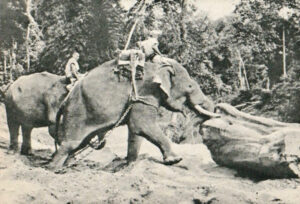
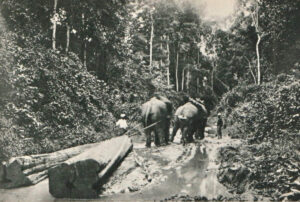 after such treatment. After World War II Williams retired to Saint Buryan, Cornwall, as an author and market gardener. He married Susan Margaret Rowland in 1932 after they met in Burma; they had a son, Treve and daughter, Lamorna while in Burma. After his death, on July 30, 1958, his wife Susan Williams wrote of her life with him in “The Footprints of Elephant Bill.”
after such treatment. After World War II Williams retired to Saint Buryan, Cornwall, as an author and market gardener. He married Susan Margaret Rowland in 1932 after they met in Burma; they had a son, Treve and daughter, Lamorna while in Burma. After his death, on July 30, 1958, his wife Susan Williams wrote of her life with him in “The Footprints of Elephant Bill.”

